Lincoln Navigator: Engine Cooling - 3.5L EcoBoost (272kW/370PS) / Engine Cooling System Draining, Vacuum Filling and Bleeding. General Procedures
Special Tool(s) / General Equipment
 |
ROB75240 Coolant/Battery Refractometer (Fahrenheit) |
| Fluid Container | |
| Cooling System Vacuum Tester and Refiller | |
Materials
| Name | Specification |
|---|---|
| Motorcraft® Orange Prediluted Antifreeze/Coolant VC-3DIL-B |
WSS-M97B44-D2 |
| Motorcraft® Yellow Concentrated Antifreeze/Coolant VC-13-G |
WSS-M97B57-A1 |
| Motorcraft® Yellow Prediluted Antifreeze/Coolant VC-13DL-G |
WSS-M97B57-A2 |
| Motorcraft® Orange Concentrated Antifreeze/Coolant VC-3-B |
WSS-M97B44-D |
Draining
NOTICE: The coolant must be recovered in a suitable, clean container for reuse. If the coolant is contaminated, it must be recycled or disposed of correctly. Using contaminated coolant may result in damage to the engine or cooling system components.
NOTICE: The engine cooling system is filled with Motorcraft® Orange Antifreeze/Coolant for vehicles built up to 08-July-2018 and Motorcraft® Yellow Antifreeze/Coolant for vehicles built from 09-July-2018. Do not mix coolant types. Mixing coolant types degrades the corrosion protection of the coolant. Failure to follow these instructions may damage the engine or cooling system.
NOTICE: Always fill the cooling system with the manufacturer's specified coolant. Chemically flush the cooling system if a non-specified coolant has been used. Refer to Cooling System Flushing. Failure to follow these instructions may damage the engine or cooling system.
NOTE: During normal vehicle operation, Motorcraft® Orange Antifreeze/Coolant may change color from orange to pink or light red. As long as the engine coolant is clear and uncontaminated, this color change does not indicate the engine coolant has degraded nor does it require the engine coolant to be drained, the system to be flushed, or the engine coolant to be replaced.
NOTE: Less than 80% of coolant capacity can be recovered with the engine in the vehicle. Dirty, rusty or contaminated coolant requires replacement.
-


Remove the pressure relief cap. WARNING:
When releasing the cooling system pressure, cover the coolant expansion tank cap with a thick cloth.
WARNING:
When releasing the cooling system pressure, cover the coolant expansion tank cap with a thick cloth.
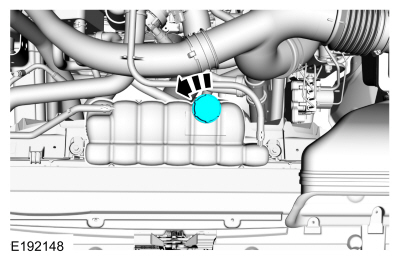 |
-
Refer to: Jacking and Lifting (100-02 Jacking and Lifting, Description and Operation).
-
If equipped.
Remove the retainers and the front underbody shield.
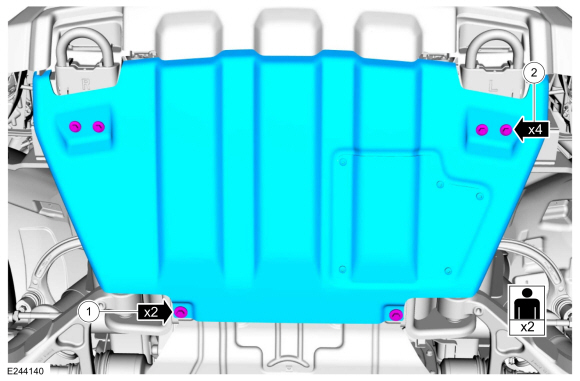 |
-

Connect a hose to drain the coolant. Open the radiator drain valve and drain the engine coolant in a suitable, clean container. WARNING:
Be prepared to collect escaping fluid.
WARNING:
Be prepared to collect escaping fluid.
Use the General Equipment: Fluid Container
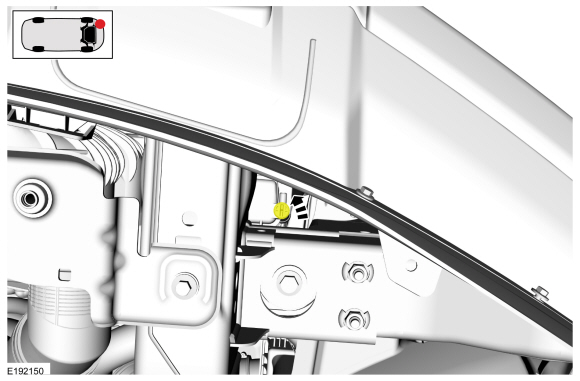 |
Filling
Filling and Bleeding with a Vacuum Cooling System Filler
-
-
NOTICE: The engine cooling system is filled with Motorcraft® Orange Antifreeze/Coolant for vehicles built up to 08-July-2018 and Motorcraft® Yellow Antifreeze/Coolant for vehicles built from 09-July-2018. Do not mix coolant types. Mixing coolant types degrades the corrosion protection of the coolant. Failure to follow these instructions may damage the engine or cooling system.
NOTICE: Engine coolant provides boil protection, corrosion protection, freeze protection, and cooling efficiency to the engine and cooling components. In order to obtain these protections, maintain the engine coolant at the correct concentration and fluid level in the degas bottle.
NOTE: Add Motorcraft® Orange Antifreeze/Coolant for vehicles built up to 08-July-2018 and Motorcraft® Yellow Antifreeze/Coolant for vehicles built from 09-July-2018.
NOTE: Do not add or mix with any other type of engine coolant. Mixing coolants may degrade the coolant's corrosion protection.
NOTE: Do not add alcohol, methanol, or brine, or any engine coolants mixed with alcohol or methanol antifreeze. These can cause engine damage from overheating or freezing.
NOTE: Ford Motor Company does NOT recommend the use of recycled engine coolant in vehicles originally equipped with Motorcraft® Orange Antifreeze/Coolant or Motorcraft® Yellow Antifreeze/Coolant since a Ford-approved recycling process is not yet available.
When adding or topping off the engine coolant:
-
Measure the coolant concentration in the vehicle.
Use Special Service Tool: ROB75240 Coolant/Battery Refractometer (Fahrenheit).
-
Determine the concentration desired based on the
vehicle duty cycle of extreme hot or cold operating conditions.
-
Add, top-off or adjust the coolant as follows:
-
For concentrations measured 48/52 to 50/50
(freeze protection -34˚C to -37˚C [-30˚F to -34˚F]) use Motorcraft®
Prediluted Antifreeze/Coolant to maintain a coolant concentration in
this same range.
Material: Motorcraft® Orange Prediluted Antifreeze/Coolant / VC-3DIL-B (WSS-M97B44-D2)
Material: Motorcraft® Yellow Prediluted Antifreeze/Coolant / VC-13DL-G (WSS-M97B57-A2)
-
For all other concentrations, use Motorcraft®
Concentrated Antifreeze/Coolant and/or distilled water to get to the
desired concentration.
Material: Motorcraft® Orange Concentrated Antifreeze/Coolant / VC-3-B (WSS-M97B44-D)
Material: Motorcraft® Yellow Concentrated Antifreeze/Coolant / VC-13-G (WSS-M97B57-A1)
-
When refilling the engine coolant after a flush
procedure, use a mixture of Motorcraft® Concentrated Antifreeze/Coolant
and distilled water to get to the desired concentration.
-
-
Close the radiator drain valve.
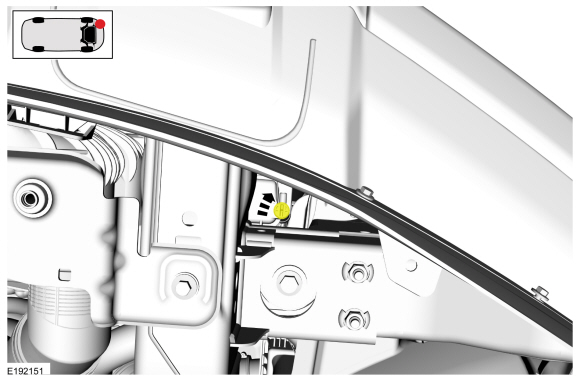 |
-
If equipped.
Install the front underbody shield and the retainers.
Torque:
1: 41 lb.ft (55 Nm)
2: 35 lb.ft (48 Nm)
 |
-
Install the vacuum cooling system filler and follow
the manufacturer's instructions to fill and bleed the system.
Use the General Equipment: Cooling System Vacuum Tester and Refiller
-
Recommended coolant concentration is 48/52 to 50/50
engine coolant to distilled water (freeze protection -34˚C to -37˚C
[-30˚F to -34˚F]).
-
-
For extremely cold climates (less than -37˚C [-34˚F]):
-
It may be necessary to increase the coolant concentration above 50%.
-
NEVER increase the coolant concentration above 60%.
-
Maximum coolant concentration is 60/40 for cold weather areas.
-
A coolant concentration of 60% provides freeze protection down to -50˚C (-58˚F)
-
Engine coolant concentrations above 60% will
decrease the overheat protection characteristics of the engine coolant
and may damage the engine.
-
For extremely cold climates (less than -37˚C [-34˚F]):
-
-
For extremely hot climates:
-
It is still necessary to maintain the coolant concentration above 40%.
-
NEVER decrease the coolant concentration below 40%.
-
Minimum coolant concentration is 40/60 for warm weather areas.
-
Engine coolant concentrations below 40% will
decrease the freeze and corrosion protection characteristics of the
engine coolant and may damage the engine.
-
For extremely hot climates:
-
Vehicles driven year-round in non-extreme climates
should use a 48/52 to 50/50 (freeze protection -34˚C to -37˚C [-30˚F to
-34˚F]) mixture of engine coolant and distilled water for optimum
cooling system and engine protection.
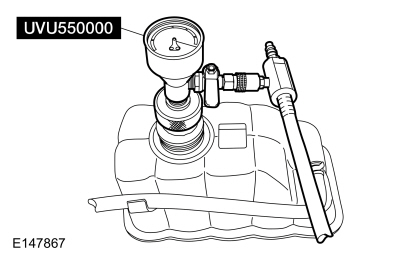 |
-
Fill the degas bottle to the MAX FILL line.
-
Install the degas bottle cap until it contacts the hard stop.
-
Turn the climate control system off.
-
Start the engine and increase the engine speed to 3,500 rpm and hold for 30 seconds.
-
Turn the engine off and wait for 1 minute to purge any large air pockets from the cooling system.
-
Check the engine coolant level in degas bottle and if necessary fill to the top of the MAX FILL line on the degas bottle if the engine is warm or to the top of the MIN FILL LEVEL if the engine is cold. WARNING:
Always allow the engine to cool before opening
the cooling system. Do not unscrew the coolant pressure relief cap when
the engine is operating or the cooling system is hot. The cooling system
is under pressure; steam and hot liquid can come out forcefully when
the cap is loosened slightly. Failure to follow these instructions may
result in serious personal injury.
WARNING:
Always allow the engine to cool before opening
the cooling system. Do not unscrew the coolant pressure relief cap when
the engine is operating or the cooling system is hot. The cooling system
is under pressure; steam and hot liquid can come out forcefully when
the cap is loosened slightly. Failure to follow these instructions may
result in serious personal injury.
-
Start the engine and let it idle until the engine
reaches normal operating temperature and the thermostat is fully open. A
fully open thermostat is verified by the cooling fan cycling on at
least once.
-
Increase the engine speed to 3,500 rpm and hold for 30 seconds.
-
Allow the engine to idle for 30 seconds.
-
Turn the engine off for 1 minute.
-
Repeat steps 15 through 17 a total of 10 times to remove any remaining air trapped in the system.
-
Check the engine coolant level in degas bottle and if necessary fill to the top of the MAX FILL line on the degas bottle. WARNING:
Always allow the engine to cool before opening
the cooling system. Do not unscrew the coolant pressure relief cap when
the engine is operating or the cooling system is hot. The cooling system
is under pressure; steam and hot liquid can come out forcefully when
the cap is loosened slightly. Failure to follow these instructions may
result in serious personal injury.
WARNING:
Always allow the engine to cool before opening
the cooling system. Do not unscrew the coolant pressure relief cap when
the engine is operating or the cooling system is hot. The cooling system
is under pressure; steam and hot liquid can come out forcefully when
the cap is loosened slightly. Failure to follow these instructions may
result in serious personal injury.
-
Install the pressure relief cap until it contacts the hard stop.
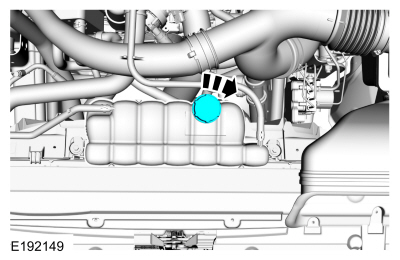 |
Filling and Bleeding without a Vacuum Cooling System Filler
-
-
NOTICE: The engine cooling system is filled with Motorcraft® Orange Antifreeze/Coolant for vehicles built up to 08-July-2018 and Motorcraft® Yellow Antifreeze/Coolant for vehicles built from 09-July-2018. Do not mix coolant types. Mixing coolant types degrades the corrosion protection of the coolant. Failure to follow these instructions may damage the engine or cooling system.
NOTICE: Engine coolant provides boil protection, corrosion protection, freeze protection, and cooling efficiency to the engine and cooling components. In order to obtain these protections, maintain the engine coolant at the correct concentration and fluid level in the degas bottle.
NOTE: Add Motorcraft® Orange Antifreeze/Coolant for vehicles built up to 08-July-2018 and Motorcraft® Yellow Antifreeze/Coolant for vehicles built from 09-July-2018.
NOTE: Do not add or mix with any other type of engine coolant. Mixing coolants may degrade the coolant's corrosion protection.
NOTE: Do not add alcohol, methanol, or brine, or any engine coolants mixed with alcohol or methanol antifreeze. These can cause engine damage from overheating or freezing.
NOTE: Ford Motor Company does NOT recommend the use of recycled engine coolant in vehicles originally equipped with Motorcraft® Orange Antifreeze/Coolant or Motorcraft® Yellow Antifreeze/Coolant since a Ford-approved recycling process is not yet available.
When adding or topping off the engine coolant:
-
Measure the coolant concentration in the vehicle.
Use Special Service Tool: ROB75240 Coolant/Battery Refractometer (Fahrenheit).
-
Determine the concentration desired based on the
vehicle duty cycle of extreme hot or cold operating conditions.
-
Add, top-off or adjust the coolant as follows:
-
For concentrations measured 48/52 to 50/50
(freeze protection -34˚C to -37˚C [-30˚F to -34˚F]) use Motorcraft®
Prediluted Antifreeze/Coolant to maintain a coolant concentration in
this same range.
Material: Motorcraft® Orange Prediluted Antifreeze/Coolant / VC-3DIL-B (WSS-M97B44-D2)
Material: Motorcraft® Yellow Prediluted Antifreeze/Coolant / VC-13DL-G (WSS-M97B57-A2)
-
For all other concentrations, use Motorcraft®
Concentrated Antifreeze/Coolant and/or distilled water to get to the
desired concentration.
Material: Motorcraft® Orange Concentrated Antifreeze/Coolant / VC-3-B (WSS-M97B44-D)
Material: Motorcraft® Yellow Concentrated Antifreeze/Coolant / VC-13-G (WSS-M97B57-A1)
-
When refilling the engine coolant after a flush
procedure, use a mixture of Motorcraft® Concentrated Antifreeze/Coolant
and distilled water to get to the desired concentration.
-
-
Close the radiator drain valve.
 |
-
If equipped.
Install the front underbody shield and the retainers.
Torque:
1: 41 lb.ft (55 Nm)
2: 35 lb.ft (48 Nm)
 |
-
Fill the degas bottle to the MAX FILL line.
-
Recommended coolant concentration is 48/52 to 50/50
engine coolant to distilled water (freeze protection -34˚C to -37˚C
[-30˚F to -34˚F]).
-
-
For extremely cold climates (less than -37˚C [-34˚F]):
-
It may be necessary to increase the coolant concentration above 50%.
-
NEVER increase the coolant concentration above 60%.
-
Maximum coolant concentration is 60/40 for cold weather areas.
-
A coolant concentration of 60% provides freeze protection down to -50˚C (-58˚F)
-
Engine coolant concentrations above 60% will
decrease the overheat protection characteristics of the engine coolant
and may damage the engine.
-
For extremely cold climates (less than -37˚C [-34˚F]):
-
-
For extremely hot climates:
-
It is still necessary to maintain the coolant concentration above 40%.
-
NEVER decrease the coolant concentration below 40%.
-
Minimum coolant concentration is 40/60 for warm weather areas.
-
Engine coolant concentrations below 40% will
decrease the freeze and corrosion protection characteristics of the
engine coolant and may damage the engine.
-
For extremely hot climates:
-
Vehicles driven year-round in non-extreme climates
should use a 48/52 to 50/50 (freeze protection -34˚C to -37˚C [-30˚F to
-34˚F]) mixture of engine coolant and distilled water for optimum
cooling system and engine protection.
-
Install the degas bottle cap until it contacts the hard stop.
-
Turn the climate control system off.
-
Start the engine and increase the engine speed to 3,500 rpm and hold for 30 seconds.
-
Turn the engine off and wait for 1 minute to purge any large air pockets from the cooling system.
-
Check the engine coolant level in degas bottle and if necessary fill to the top of the MAX FILL line on the degas bottle if the engine is warm or to the top of the MIN FILL LEVEL if the engine is cold. WARNING:
Always allow the engine to cool before opening
the cooling system. Do not unscrew the coolant pressure relief cap when
the engine is operating or the cooling system is hot. The cooling system
is under pressure; steam and hot liquid can come out forcefully when
the cap is loosened slightly. Failure to follow these instructions may
result in serious personal injury.
WARNING:
Always allow the engine to cool before opening
the cooling system. Do not unscrew the coolant pressure relief cap when
the engine is operating or the cooling system is hot. The cooling system
is under pressure; steam and hot liquid can come out forcefully when
the cap is loosened slightly. Failure to follow these instructions may
result in serious personal injury.
-
Start the engine and let it idle until the engine
reaches normal operating temperature and the thermostat is fully open. A
fully open thermostat is verified by the cooling fan cycling on at
least once.
-
Increase the engine speed to 3,500 rpm and hold for 30 seconds.
-
Allow the engine to idle for 30 seconds.
-
Turn the engine off for 1 minute.
-
Repeat steps 34 through 36 a total of 10 times to remove any remaining air trapped in the system.
-
Check the engine coolant level in degas bottle and if necessary fill to the top of the MAX FILL line on the degas bottle. WARNING:
Always allow the engine to cool before opening
the cooling system. Do not unscrew the coolant pressure relief cap when
the engine is operating or the cooling system is hot. The cooling system
is under pressure; steam and hot liquid can come out forcefully when
the cap is loosened slightly. Failure to follow these instructions may
result in serious personal injury.
WARNING:
Always allow the engine to cool before opening
the cooling system. Do not unscrew the coolant pressure relief cap when
the engine is operating or the cooling system is hot. The cooling system
is under pressure; steam and hot liquid can come out forcefully when
the cap is loosened slightly. Failure to follow these instructions may
result in serious personal injury.
-
Install the pressure relief cap until it contacts the hard stop.
 |
 Engine Temperature. Diagnosis and Testing
Engine Temperature. Diagnosis and Testing
Diagnostic Trouble Code (DTC) Chart
Diagnostics in this manual assume a certain skill level and knowledge of Ford-specific diagnostic practices. REFER to: Diagnostic Methods (100-00 General Information, Description and Operation)...
 Engine Cooling System Flushing. General Procedures
Engine Cooling System Flushing. General Procedures
Materials
Name
Specification
Motorcraft® Premium Cooling System FlushVC-1
ESR-M14P7-A
Flushing
WARNING:
Always allow the engine to cool before opening the cooling
system...
Other information:
Lincoln Navigator 2018-2025 Workshop Manual: Head Up Display (HUD) - System Operation and Component Description. Description and Operation
System Operation System Diagram *.sttxt { visibility: hidden; } *.stcallout { visibility: visible; } 1 SODx ..
Lincoln Navigator 2018-2025 Workshop Manual: Low Voltage Differential Signalling (LVDS) Cable. Removal and Installation
Removal Remove the APIM . Refer to: Information and Entertainment System - Component Location (415-00 Information and Entertainment System - General Information - Vehicles With: SYNC 4, Description and Operation). Remove the FDIM . Refer to: Information and Entertainment System - Component Location (415-00 Information and Entertainment System - General..
Categories
- Manuals Home
- 4th Gen Lincoln Navigator Service Manual (2018 - 2025)
- Transmission Fluid Level Check. General Procedures
- Front Seat. Removal and Installation
- Telematics Control Unit (TCU) Module. Removal and Installation
- All Terrain Control Module (ATCM). Removal and Installation
- Liftgate Trim Panel. Removal and Installation
Wheel to Hub Runout Minimization. General Procedures
Check
NOTE: Wheel-to-hub optimization is important. Clearance between the wheel and hub can be used to offset or neutralize the Road Force® or run-out of the wheel and tire assembly. For every 0.001 inch of wheel-to-hub clearance, the Road Force® can be affected between 1 and 3 pounds depending on the tire stiffness.
NOTE: The example below illustrates how the clearance between the wheel and the hub can be used to offset the high spot of radial run-out or Road Force®. Following the procedure will make sure of the best optimization.
Position the wheel and tire assembly on the vehicle so that the high spot location of radial run-out or Road Force® is at the 6 o'clock position and